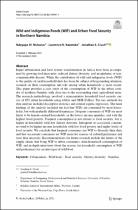| dc.contributor.author | Crush, Jonathan S | |
| dc.contributor.author | Nickanor, Ndeyapo M | |
| dc.contributor.author | Kazembe, Lawrence N | |
| dc.date.accessioned | 2023-04-14T11:34:32Z | |
| dc.date.available | 2023-04-14T11:34:32Z | |
| dc.date.issued | 2023 | |
| dc.identifier.citation | Nickanor, N.M., Kazembe, L.N. and Crush, J.S., 2023, February. Wild and Indigenous Foods (WIF) and Urban Food Security in Northern Namibia. In Urban Forum (pp. 1-20). Dordrecht: Springer Netherlands. | en_US |
| dc.identifier.uri | https://doi.org/10.1007/s12132-023-09487-x | |
| dc.identifier.uri | http://hdl.handle.net/10566/8804 | |
| dc.description.abstract | Rapid urbanisation and food system transformation in Africa have been accompanied by growing food insecurity, reduced dietary diversity, and an epidemic of non-communicable disease. While the contribution of wild and indigenous foods (WIF) to the quality of rural household diets has been the subject of longstanding attention, research on their consumption and role among urban households is more recent. This paper provides a case study of the consumption of WIF in the urban corridor of northern Namibia with close ties to the surrounding rural agricultural areas. The research methodology involved a representative household food security sur vey of 851 urban households using tablets and ODK Collect. The key methods for data analysis included descriptive statistics and ordinal logistic regression. The main findings of the analysis included the fact that WIFs are consumed by most households, but with markedly different frequencies. Frequent consumers of WIF are most likely to be female-centred households, in the lowest income quintiles, and with the highest lived poverty. Frequent consumption is not related to food security, but is higher in households with low dietary diversity. Infrequent or occasional consumers tend to be higher-income households with low lived poverty and higher levels of food security. We conclude that frequent consumers use WIF to diversify their diets and that occasional consumers eat WIF more for reasons of cultural preference and taste than necessity. Recommendations for future research include the nature of the supply chains that bring WIF to urban consumers, intra-household consumption of WIF, and in-depth interviews about the reasons for household consumption of WIF and preferences for certain types of wild food. | en_US |
| dc.language.iso | en | en_US |
| dc.publisher | Urban Forum | en_US |
| dc.subject | urbanisation | en_US |
| dc.subject | wild foods | en_US |
| dc.subject | food security | en_US |
| dc.subject | dietary diversity | en_US |
| dc.subject | Namibia | en_US |
| dc.title | Wild and indigenous foods (wif) and urban food security in northern Namibia | en_US |
| dc.type | Article | en_US |

